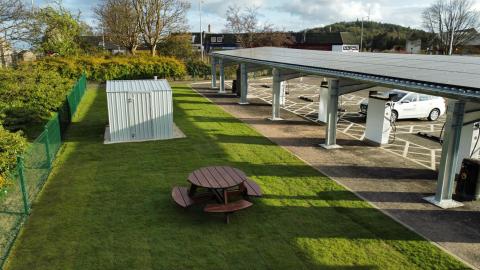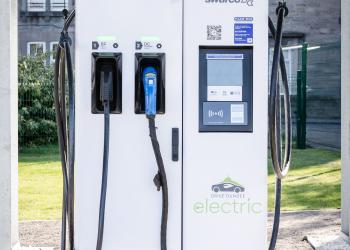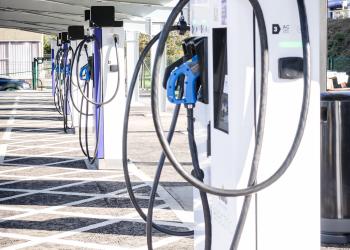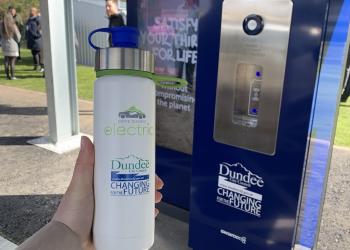Dundee City Council delivered its first accessible rapid charging hub.
Improving accessibility of charge points in Dundee through exploring and installing more charge points that are compliant with the PAS 1899:2022.

Dundee City Council
Go To WebsiteAddressed Challenges:
- Tech & innovation
- Carbon emissions
- Greater fairness/ Just transition
Action Areas:
- Transport
Initiative Purpose:
- Mitigation & Adaptation
The Story

After declaring a city-wide climate emergency in 2019, Dundee City Council published its Climate Action Plan, which sets out a first set of ambitious actions in a long-term pathway to support Dundee in a just transition to a net-zero and climate resilient future by 2045 at the latest. The plan builds on considerable work that can be achieved by the public with assistance from the council including the importance of increasing the uptake of electric vehicles by the public through the deployment of charging infrastructure.
Recently named as one of the UK’s EV leading cities, the challenge for Dundee was to ensure that EV charging is as accessible as possible, meeting the needs of wider communities. With the opening of the 4th charging hub on Clepington Road in April 2023, Dundee is now one step closer to achieving that goal.
The charging hub was developed as part of the Levelling Up Phase 3 project, which builds on the extensive research, design and development work undertaken over the course of two years by Dundee City Council and partnering industry leaders – a smart and sustainable cities consultancy Urban Foresight, charge point operator SWARCO and product design consultancy Duku. During the consultation involved in the design process, lots of energy was focused on getting feedback from drivers who require additional support.
The inclusion of motorists allowed the project to successfully identify solutions to the barriers posed by inaccessible charge points and establish a proposal for delivering genuine improvement to accessibility for motorists. Although the proposal supported PAS 1899 Guidance where possible, the final proposed solution provided an understanding of what genuine accessibility looks like. The project took a multi-faceted approach focusing on building awareness thorough training, events and guidelines, encouraging collaboration through steering group organisation and delivering real solutions alongside practical support.
The design of the charging hub was preceded by valuable discussions with disabled drivers, charities, manufacturers, which directly informed the design. We believe that this hub is the first hub in the UK to have the following combination of features that improve the accessibility at charging infrastructure:
- All bays are an accessible size of 3.6m wide and 6m long
- No kerbs preventing access to charge points
- The charge points are not on raised plinths
- Removal of bollards from around charge points
- The use of colour contrasting wheelstops in the bay to prevent vehicles from encroaching on the space around the charge points, ensuring safe access routes
- A minimum of 100cm of clear space between parked vehicle and rapid charge points Improved signage across the city and to the site
- Access for users to review accessibility provisions prior to a visit via the Dundee Drive Electric website, enabling them to familiarise themselves with the site
- Improved shelter
- Level access to and from the site
- Charge point cables are marked with contrasting colours to improve visibility and reduce trip hazards
- Longer cables to meet a wider variety of charge port locations
- Well-lit site in an area with high levels of footfall, increasing safety and confidence for vulnerable users
- A cable retention system was implemented to take some of the weight of the cable / remove trip hazard of cables on the ground
- A rest stop (bench and table) is provided on the site
Success & Outcomes
Since the hub opened in April 2023, the feedback received has been positive with some disabled drivers expressing gratitude. Dundee’s mobility systems connect people and places, improving their quality of life, as well as the social and economic outcomes for communities. The charging hub provides inspiration for city planners to consider people’s needs more broadly and incorporate innovative solutions in future projects. Although there is still much to be done in the industry when it comes to inclusivity, we hope that the 4th hub can serve as an excellent starting point for future designs that can aim to deliver on this guidance as a minimum and achieve the ‘gold standard’. Such focus on accessibility could significantly improve urban infrastructure. For Dundee City Council, this will begin improving accessibility at our sites. It is not going to be perfect, but it is a big step in the right direction.
Accessible charging infrastructure provision significantly promotes independence across all sectors and communities. Drivers can take advantage of improved access to employment, education, healthcare and leisure activities without relying on others or public transport. The new charging hub has also allowed for drivers with health conditions and impairments to be involved in the transition to e-mobility – something that they were reluctant to consider when Dundee was lacking in accessible EV charge points.
With the strategic location of the accessible charging hub, it provides further support in social activities participation. The hub was installed near many amenities including restaurants, convenience shops and beauty salons. The purified water dispenser stations at the site also act as advertising screens, which are simultaneously used as an information points. The display shows the walking distance to the nearest amenities. This ensures that the communities are not restricted in mobility due to inaccessible transportation options.
In terms of measuring success, our team looks at data regularly and compares usage data (number of sessions, unique users, kWh consumption per location, per charger, per type - 22kW, 50kW or 100kW) across the different hubs. The rapid hub at Clepington Road has consistently been in the two most popular and used hubs in Dundee along with the hub at Princes Street. Keep in mind that this hub provides 9 bays, while the hub at Princes Street provides 18 bays.
Advice for others looking to do something similar
The discussions and the event played a vital part in the research which was essential for the whole development of the site. The valuable discussion with the wide community of drivers provided an insight into what gaps future planning should cover in order to improve urban infrastructure for the wider community. This helped establish a baseline of what should be improved in terms of accessibility. We identified unique physical barriers that drivers may encounter such as insufficient space for manoeuvring a wheelchair, bollards or plinths that are in the way, placement of charging cables that may cause difficulties for users - if the placement is too high, heavy cables that are difficult to handle - causing a trip hazard when left on the ground and further limiting access to the charge point, screens that are difficult to read and operate and others. Another valuable contribution gained from this type of engagement was to learn how drivers imagine these barriers could be overcome, and how different solutions would impact them. This kind of conversation created an opportunity to further open up the discussion - would this idea solve your problem in real life? Would this address the barrier experienced by you? How about others, would this solution impact you positively or negatively? All these ideas provided valuable information that could be then taken away and discussed with other stakeholders - policymakers, charge point operators, manufacturers, product designers etc.
It was important for us as developers to be aware of the limitations posed by the market at the time. While we aspired to incorporate solutions that would be inclusive to all needs, it was impossible to accommodate this. The developers were cautious about stating that the hub would be ‘fully accessible’. Even with careful planning, certain solutions may accommodate the specific needs of some individuals while unintentionally excluding others. For example, the screen's placement can cause some difficulties for developers - if you think of adapting the screen placement so that it doesn't require users to bend to be able to see the screen, you may unintentionally affect the usability of wheelchair users who may struggle to reach the screen or be able to read it from their position. This is when developers will need to consider a height that can work for both groups or maybe having screens at different heights or ones that can be adjusted to different heights. This type of argument should be discussed for other similar features of a standard charge point such as connectors, sockets, cables etc. It was also found early in the process that certain visions can seem simple until you try to incorporate them into a project within a limited timeframe and budget. During the planning process, we realised that some elements improving accessibility that we had envisioned were not readily available on the market, and with limited resources, it was unfeasible to design and create them. Consequently, the site's design only employed tested and endorsed solutions.
If we could provide some guidance for future developers, we would say that the solutions implemented at our charging hub have been tested and we know that the combination does work, so it would be an excellent starting point. We are excited and hopeful for the future where our hub is set as a standard and other solutions are implemented on top of our standard - especially if they're in a position where they are able to make large investments in the infrastructure - design and create new solutions.
We need to remember that the industry is continuously developing. It will be interesting to see what the industry will have to offer in the future in terms of accessibility. As innovation continues to expand and the industry start to adapt their products, it will be interesting to see what products are available at the time. The industry will have to adapt to government legislation and ensure that the process of refuelling
https://www.drivedundeeelectric.co.uk/news/2023/04/26/press-release



